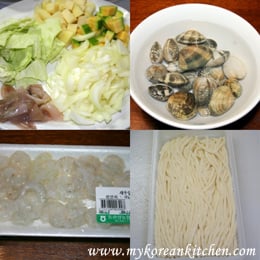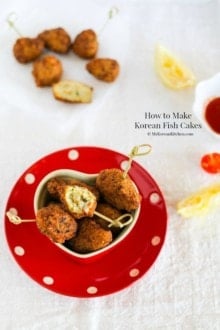Seafood Jajangmyeon (Korean black bean noodles with seafood) is another way to enjoy popular Korean black bean noodles. It’s loaded with delicious and savory seafood!

There are a few different types of Jajangmyeon (Korean black bean noodles, 자장면) based on the ingredients used or the way it’s served.
This seafood Jajangmyeon is one of the varieties available at a typical Korean Chinese restaurant.
In Korean, it’s called Samseon Jajangmyeon (삼선 자장면). Samseon (三鮮) means 3 fresh sea ingredients such as squid, shrimps, sea cucumbers but it does not include fish. (I do not know why!) Another Korean name for Seafood Jajangmyeon is Haemul Jajangmyeon (해물 자장면). (Haemul means seafood in English.)
The cooking method is nearly the same as a regular Jajangmyeon, just some ingredients, and cooking method of those ingredients, are different.
I hope you try this soon, and tell me which one you prefer!
Ingredients for Seafood Jajangmyeon (2 servings)
(Expected preparation time, excluding shellfish soaking time – 5 minutes, Cooking time – 20 minutes)
Main
- 2 packs fresh ramen or udon noodles

- 90g/3 ounces shelled shrimps, cleaned
- 200g/7 ounces littleneck clams, cleaned
- 1 small squid, cut into ring shapes
- 1 onion, cubed
- 1 medium potato, cubed
- 1 cabbage leaf, cut into medium pieces
- 1/4 zucchini, cubed
- 2 and 1/2 cups water to boil seafood
- Some cooking oil
Korean Black Bean Sauce
- 2 Tbsp Korean black bean paste (Chunjang)
- 2 Tbsp olive oil
- 2 Tbsp dark brown sugar
- 1 tsp cooking syrup (corn syrup) or honey
- 2 Tbsp rice wine
- 4 Tbsp starch water (mix of potato starch 2 Tbsp +water 2 Tbsp)
*1 Tbsp = 15 ml
**If you want to learn more about Korean ingredients, check my 30 essential Korean cooking ingredients list!
How to Make Seafood Jajangmyeon
1. Boil the water (2 and 1/2 cups) in a pot, and parboil the seafood (shrimps, shellfish, squid). Drain the seafood and set aside. Keep 2 cups of broth from this boiled water.

2. Pre-heat a wok and add some cooking oil. Add the potatoes and stir fry it over medium-high heat.
3. Add the zucchini, onion, and cabbage, stir them.
4. Pre-heat a frying pan and add the olive oil and black bean paste. Stir it on medium heat for 1 minute.
5. Scoop out the black bean paste without the oil. Add it to the wok (from step 3). Mix the vegetables with the stir fried black bean paste.
6. Add the cooking syrup, sugar, and rice wine into the wok. Stir it. Add the broth (from step 1) and boil until all vegetables are cooked.
Add the broth (from step 1) and boil until all vegetables are cooked.
7. Add the boiled seafood (from step 1) and the starch water into the wok. Stir it. (It is the final stage of making the sauce.)
8. While the sauce is being made (near the end of step 6) boil some water in a pot. Cook the noodles following the manufacturer’s instructions. Drain and rinse the noodles.

9. Place the noodles in a serving bowl then add the black bean sauce (from step 7) on top of the noodles.
10. You can serve it on its own or top it up with some sliced cucumbers, boiled or fried egg or cooked green beans. (In my case, I used some radish sprouts.)

How to Eat Jajangmyeon
- Mix the sauce and the noodles well with chopsticks. Dig in.
- It is ideal to have these noodles with some yellow pickled radish. Apparently, it helps with digestion.
- Also, mix it up quickly before the noodles get swollen.

Seafood Jajangmyeon
Ingredients
MAIN
- 2 pack fresh ramen or udon noodles
- 90 g shelled shrimps (3 ounces), cleaned
- 200 g littleneck clams (7 ounces), cleaned
- 1 small squid , cut into ring shapes
- 1 onion , cubed
- 1 medium potato , cubed
- 1 cabbage leaf , cut into medium pieces
- 1/4 zucchini , cubed
- 2 1/2 cups water , to boil seafood
- Some cooking oil
- Some water to boil the noodles
KOREAN BLACK BEAN SAUCE
- 2 Tbsp Korean black bean paste (Chunjang)
- 2 Tbsp olive oil
- 2 Tbsp dark brown sugar
- 1 tsp cooking syrup (corn syrup) or honey
- 2 Tbsp rice wine
- 2 Tbsp starch water (mix of potato starch 2 Tbsp +water 2 Tbsp)
Instructions
- Boil the water (2 and 1/2 cups) in a pot, and parboil the seafood (shrimps, shellfish, squid). Drain the seafood and set aside. Keep 2 cups of broth from this boiled water.
- Pre-heat a wok and add some cooking oil. Add the potatoes and stir fry it over medium-high heat.
- Add the zucchini, onion, and cabbage, stir them.
- Pre-heat a frying pan and add the olive oil and black bean paste. Stir it on medium heat for 1 minute.
- Scoop out the black bean paste without the oil. Add it to the wok (from step 3). Mix the vegetables with the stir fried black bean paste.
- Add the cooking syrup, sugar, and rice wine into the wok. Stir it. Add the broth (from step 1) and boil until all vegetables are cooked.
- Add the boiled seafood (from step 1) and the starch water into the wok. Stir it. (It is the final stage of making the sauce.)
- While the sauce is being made (near the end of step 6) boil some water in a pot. Cook the noodles following the manufacturer’s instruction. Drain and rinse the noodles.
- Place the noodles in a serving bowl then add the black bean sauce (from step 7) on top of the noodles.
- You can serve it on its own or top it up with some sliced cucumbers, boiled or fried egg or cooked green beans. (In my case, I used some radish sprouts.)
Nutrition Info (per serving)
The nutrition information shown is an estimate provided by an online nutrition calculator. It should not be considered a substitute for a professional nutritionist’s advice.


